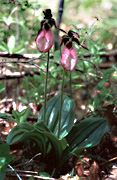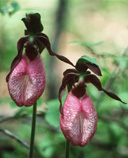Cypripedium acaule Aiton
Pink lady's slipper, pink moccasin-flower
The specific epithet acaule is the Latin meaning "stemless,"
in reference to the leafless stem of this species.


DESCRIPTION: Plant
arising from a rhizome with a fascicle of fibrous roots. Leaves two,
basal, plicate and pubescent; elliptic, 10-25 cm long and (5)8-15 cm wide.
Flower solitary, terminating a stalk 25 to 40 cm long that arises
from between the two leaves; flower subtended by a green bract 3-5 cm long
by 1-1.5 cm wide. Sepals apparently two (the result of the fusion
of the two lateral sepals behind the labellum), lanceolate, 3-5 cm long
and 0.5-2 cm wide, purplish-brown to brown, often striped with green. Petals
similar in size and appearance to the sepals, 4-6 cm long and 1-1.5 cm wide.
Labellum pouch-shaped, inflated, 4-6 cm long by 2.5-4 cm wide, opening
by a slit (with inrolled edges) at the front; magenta to whitish-pink, often
whitish pink with darker pink venation, rarely all white.
SIMILAR SPECIES: Cypripedium acaule could probably be confused
only with other pinkishCypripedium species such as C.
arietinum and C. reginae. However,
it is easily separated from these two as they have cauline leaves, whereas
the leaves of C. acaule are always basal.
HABITAT: Cypripedium acaule can be found in two distinct habitat
types in Wisconsin: dry, acidic woods, typically on slopes or steep hillsides,
and in sphagnum bogs.
FLOWERING DATES: May 20 to July 20, blooming earlier in the southern
part of the state and later in the north.
POLLINATION: Cypripedium acaule, like the other Cypripediums
in Wisconsin, has a deceptive pollination system. Bumblebees are lured into
the pouch of the labellum through the slit in the front, attracted by the
bright color and sweet scent of the flower. Once inside, they find no reward,
and discover that they are trapped--with only one point of escape. Inside
the pouch, there are hairs which lead to a pair of openings, one beneath
each pollen mass. First, however, the bee must pass under the stigma, so
if it bears any pollen from a visit to another flower, it will be deposited
before picking up a fresh load, thus preventing self-pollination. Unfortunately,
the bees quickly learn from their experiences and soon avoid C. acaule
flowers. Thus, like several other orchids in our flora, they are dependent
on naive bees, and generally experience very low pollination rates (Davis
1986).
DISCUSSION: Fuller (1933) noted
that C. acaule always grows with its roots in acid soil; root horizon
soil pH tested at a number sites in Wisconsin ranged from pH 4-5. He also
records that the white-flowered form has been collected in Adams and Rock
counties.
WI DISTRIBUTION:  U.S. DISTRIBUTION:
U.S. DISTRIBUTION:
Go directly to Wisconsin herbarium records.
Return
to the main LIST of the Orchids of Wisconsin.
Return to the main KEY to the Orchids of
Wisconsin.


 U.S. DISTRIBUTION:
U.S. DISTRIBUTION: